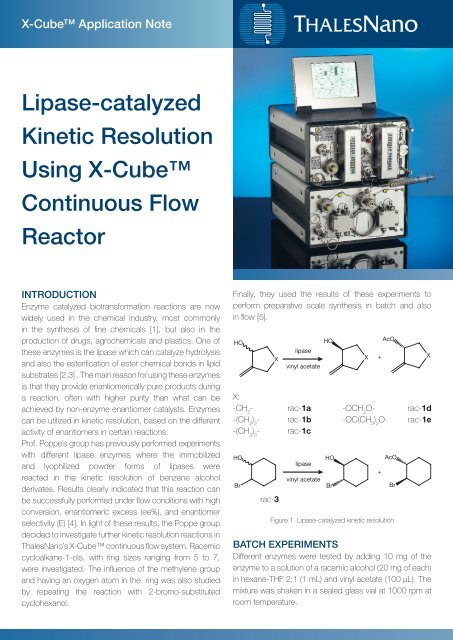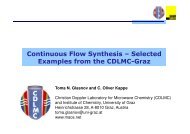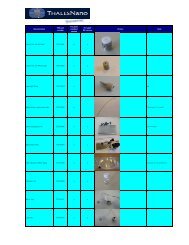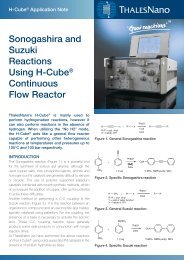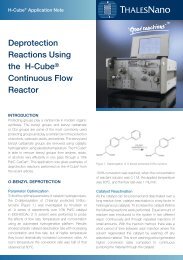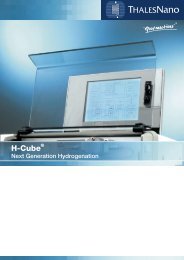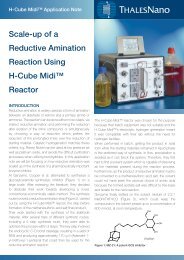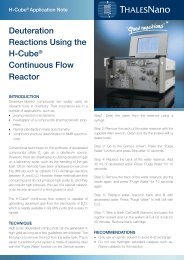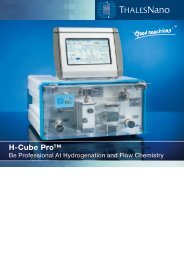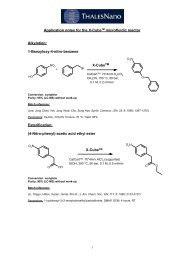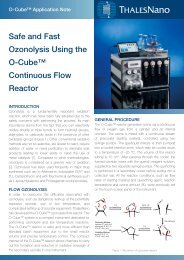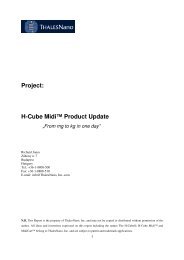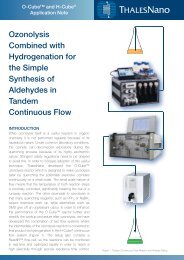Lipase-catalyzed Kinetic Resolution Using X-Cube ... - ThalesNano
Lipase-catalyzed Kinetic Resolution Using X-Cube ... - ThalesNano
Lipase-catalyzed Kinetic Resolution Using X-Cube ... - ThalesNano
You also want an ePaper? Increase the reach of your titles
YUMPU automatically turns print PDFs into web optimized ePapers that Google loves.
X-<strong>Cube</strong> Application Note<br />
<strong>Lipase</strong>-<strong>catalyzed</strong><br />
<strong>Kinetic</strong> <strong>Resolution</strong><br />
<strong>Using</strong> X-<strong>Cube</strong><br />
Continuous Flow<br />
Reactor<br />
INTRODUCTION<br />
Enzyme <strong>catalyzed</strong> biotransformation reactions are now<br />
widely used in the chemical industry, most commonly<br />
in the synthesis of fine chemicals [1], but also in the<br />
production of drugs, agrochemicals and plastics. One of<br />
these enzymes is the lipase which can catalyze hydrolysis<br />
and also the esterification of ester chemical bonds in lipid<br />
substrates [2,3] . The main reason for using these enzymes<br />
is that they provide enantiomerically pure products during<br />
a reaction, often with higher purity than what can be<br />
achieved by non-enzyme enantiomer catalysts. Enzymes<br />
can be utilized in kinetic resolution, based on the different<br />
activity of enantiomers in certain reactions.<br />
Prof. Poppe’s group has previously performed experiments<br />
with different lipase enzymes where the immobilized<br />
and lyophilized powder forms of lipases were<br />
reacted in the kinetic resolution of benzene alcohol<br />
derivates. Results clearly indicated that this reaction can<br />
be successfully performed under flow conditions with high<br />
conversion, enantiomeric excess (ee%), and enantiomer<br />
selectivity (E) [4]. In light of these results, the Poppe group<br />
decided to investigate further kinetic resolution reactions in<br />
<strong>ThalesNano</strong>’s X-<strong>Cube</strong> continuous flow system. Racemic<br />
cycloalkane-1-ols, with ring sizes ranging from 5 to 7,<br />
were investigated. The influence of the methylene group<br />
and having an oxygen atom in the ring was also studied<br />
by repeating the reaction with 2-bromo-substituted<br />
cyclohexanol.<br />
Finally, they used the results of these experiments to<br />
perform preparative scale synthesis in batch and also<br />
in flow [5].<br />
X:<br />
-CH 2 - rac-1a -OCH 2 O- rac-1d<br />
-(CH 2 ) 2 - rac-1b -OC(CH 3 ) 2 O- rac-1e<br />
-(CH 2 ) 3 - rac-1c<br />
rac-3<br />
Figure 1. <strong>Lipase</strong>-<strong>catalyzed</strong> kinetic resolution<br />
BATCH EXPERIMENTS<br />
Different enzymes were tested by adding 10 mg of the<br />
enzyme to a solution of a racemic alcohol (20 mg of each)<br />
in hexane-THF 2:1 (1 mL) and vinyl acetate (100 µL). The<br />
mixture was shaken in a sealed glass vial at 1000 rpm at<br />
room temperature.
X-<strong>Cube</strong> Application Note<br />
RESULTS OF BATCH EXPERIMENTS<br />
The best selectivities were observed with lipases from<br />
the Pseudomonas strains (<strong>Lipase</strong> AK and <strong>Lipase</strong> PS),<br />
lipase B from Candida antarctica, and lipase BUTE 3b.<br />
α-Chymotrypsin and papain were inactive in the acylation<br />
of the above molecules, although rac-1e was not accepted<br />
by the enzymes so it was not further investigated. The<br />
results detailed in the publication showed higher enantiomericaccess<br />
in the kinetic resolution of five and sixmembered<br />
ring substrates compared to the sevenmembered<br />
ones. Having an oxygen heteroatom in the<br />
seven-membered rings increased the rate and the stereoselectivity<br />
of the reaction, apart from one exception. When<br />
compared with the bromide substituted compound, which<br />
does not contain a double bond function, the 2-methylene<br />
-substituted compound showed significantly faster<br />
reaction rates, although the stereoselectivities were almost<br />
the same for both of the six-membered ring alcohols.<br />
CONTINUOUS FLOW PROCEDURE<br />
The solution of racemic alcohol (10 mg/mL; 0.090 M for<br />
rac-1b, 0.077 M for rac-1d, 0.057 M for rac-3) in a<br />
hexane-THF-vinyl acetate 2:1:1 mixture was pumped<br />
Substrate Mode Enzyme<br />
time<br />
/ h<br />
T<br />
/ °C<br />
PREPARATIVE SCALE SYNTHESIS<br />
IN BATCH<br />
A 30 times larger sample (33 mL) was used compared<br />
to the previous experiments, but at a lower substrate<br />
concentration (10 mg/mL) to be able to compare the<br />
batch result with the flow. At the end of the reaction, the<br />
enzyme was filtered off and the filtrate was concentrated<br />
under vacuum. The residue was separated by column<br />
chromatography (silica gel, 5–40% gradient of EtOAc in<br />
hexane).<br />
through the lipase-filled CatCart ® column. Runs were<br />
performed under various conditions [temperature (20–60<br />
°C) and flow rate (0.1–0.3 mL/min)]. Samples were<br />
collected and analyzed during stable operation (GC<br />
samples taken every 10 min between 30 min and 90<br />
min after changing the conditions).<br />
COMPARISON BETWEEN BATCH<br />
AND FLOW CONDITIONS<br />
Based on the results of previous experiments, the<br />
comparison reactions were performed using substituted<br />
cyclohexane, seven-membered heterocycle ring and<br />
bromide substituted cyclohexane derivates in the<br />
presence of CaLB and Sol-gel LAK enzymes . The batch<br />
reactions were carried out as described above and<br />
samples were taken at 2, 4, 8 and 24 hours. In Table<br />
1. the results of each representative experiment shows<br />
that when using a flow reactor less time is needed to<br />
reach the same conversion and that the productivity of the<br />
flow reactor was always higher than the corresponding<br />
batch reaction. The productivity of the flow reactor could<br />
be increased by raising the flow rate in conjunction with<br />
elevated temperature.<br />
v / mL<br />
/ min<br />
Conversion<br />
/ %<br />
Table 1. Results of comparison reactions between batch and flow methods<br />
ee<br />
/ %<br />
PREPARATIVE SCALE SYNTHESIS<br />
IN FLOW<br />
Similarly to the flow reactions above, a 10 mg/mL<br />
substrate concentration was used, but this time at 50°C<br />
and at a flow rate of 0.2 mL/min. After collecting 36 mL of<br />
reaction mixture, the solvent was removed under vacuum<br />
and the residue was separated as described in the batch<br />
process.<br />
E<br />
r / µmol<br />
/ min*g<br />
rac-1b Batch CaLB 24 RT - 53 98.5 65 2.0<br />
rac-1b Flow CaLB 1.5 50 0.2 52 97.7 75 17.0<br />
rac-1d Batch Sol-gel LAK 24 RT - 48 >99 >200 2.6<br />
rac-1d Flow Sol-gel LAK 1.5 40 0.1 35 99 >200 6.7<br />
rac-3 Batch CaLB 24 RT - 54 98.8 65 1.7<br />
rac-3 Flow CaLB 1.5 60 0.3 52 96.9 79 17.6
Substrate Mode Enzyme<br />
RESULTS OF PREPARATIVE SCALE<br />
SYNTHESIS<br />
Table 2 clearly indicates that almost the same results<br />
could be achieved in batch and flow when comparing<br />
yield and ee of unreacted alcohol and formed acetate.<br />
The E values showed just a slight difference, but, in all<br />
cases, performing the study in flow resulted in 2-4 times<br />
higher productivity over batch.<br />
CONCLUSION<br />
These experiments demonstrated the affect of the size and<br />
nature of the ring on enantiomeric selectivity in the kinetic<br />
resolution of secondary alcohols by lipase-<strong>catalyzed</strong><br />
acetylation. The comparison reactions between batch<br />
and continuous flow showed less time was needed to<br />
perform the reactions in flow in order to achieve the same<br />
results in terms of enantiomeric excess and conversion.<br />
From the preparative scale experiments it can be seen<br />
that by using flow methodology higher productivity can be<br />
achieved.<br />
Figure 2. Preparative scale lipase-<strong>catalyzed</strong> kinetic resolution in flow<br />
Unreacted alcohol Formed acetate<br />
time<br />
/ h Yield / % ee / % Yield /% ee / %<br />
Table 2. Results of preparative scale synthesis<br />
X-<strong>Cube</strong> Application Note<br />
References<br />
1.) Panke, S., Held, M.; Wubbolts, M.; Trends and<br />
innovations in industrial biocatalysis for the<br />
production of fine chemicals; Current Opinion in<br />
Biotechnology; 2004, 15; 272–279<br />
2.) Svendsen, A.; <strong>Lipase</strong> protein engineering;<br />
Biochimica et Biophysica Acta; 2000; 1543; 223-238<br />
3.) Reetz, M. T.; <strong>Lipase</strong>s as practical biocatalysts;<br />
Current Opinion in Chemical Biology; 2002; 6; 145–150<br />
4.) Csajagi, Cs.; Szatzker, G.; Toke, E.R.; Urge, L.;<br />
Darvas, F.; Poppe, L., Enantiomer selective acylation<br />
of racemic alcohols by lipases in continuous-flow bioreactors,<br />
Tetrahedron: Asymmetry, 2008, 19(2), 237-246<br />
5.) Tomin, A.; Hornyanszky, G.; Kupai, K.; Dorko, Zs.;<br />
Urge, L.; Darvas, F.; Poppe, L.; <strong>Lipase</strong>-<strong>catalyzed</strong><br />
kinetic resolution of 2-methylene-substituated<br />
cycloalkanols in batch and continuous-flow modes;<br />
Process Biochemistry, 2010, 45, 859-865<br />
E<br />
r / µmol<br />
/ min*g<br />
rac-1b Batch CaLB 6 16 89.2 47 89.0 51 8.9<br />
rac-1b Flow CaLB 3 17 92.9 48 90.0 93 16.9<br />
rac-1d Batch Sol-gel LAK 24 42 40.8 19 98.8 >200 1.4<br />
rac-1d Flow Sol-gel LAK 3 43 34.8 15 98.9 >200 5.7<br />
rac-3 Batch CaLB 8 34 92.1 48 91.0 65 4.2<br />
rac-3 Flow CaLB 3 35 98.0 48 85.0 55 11.9
X-<strong>Cube</strong> Application Note<br />
<strong>ThalesNano</strong> Nanotechnology Inc.<br />
Zahony u. 7.<br />
H-1031 Budapest<br />
Hungary<br />
Tel.: +36 1 880 8500<br />
Fax.: +36 1 880 8501<br />
E-mail: sales@thalesnano.com<br />
US Office <strong>ThalesNano</strong><br />
50 S. Penn St. Suite B-2<br />
Hatboro<br />
PA. 19040<br />
USA<br />
Tel.: +1 732 274 3388<br />
E-mail: USAsales@thalesnano.com<br />
<strong>ThalesNano</strong>’s CatCarts ®<br />
<strong>ThalesNano</strong>’s CatCart ® columns contain sealed heterogeneous<br />
or immobilized homogeneous catalysts and<br />
reagents, which can be used in heterogeneously<br />
<strong>catalyzed</strong> reactions in the X-<strong>Cube</strong> flow reactor.<br />
Exposure to the catalyst is limited by removing the<br />
need for filtration, while the cartridges are easy<br />
to install and replace. In the CatCart ® columns, the<br />
ratio of catalyst/reagent to substrate in the solution is<br />
significantly increased, which results in faster reaction<br />
rates and shortened processing time increasing<br />
productivity.<br />
CatCart Packer<br />
Users can now pack their own catalysts/reagents in a<br />
safe, easy and cost effective way with our new CatCart<br />
Packer instrument.<br />
The CatCart Packer system enables users of the<br />
X-<strong>Cube</strong> flow reactor to pack their own catalysts into<br />
cartridges and screen them for rapid optimization.<br />
<strong>Using</strong> the CatCart Packer instrument takes three<br />
simple steps: adding the catalyst/reagent, adding the<br />
filters and sealing the CatCart ® column. After filling and<br />
sealing the CatCart ® column is ready for use. After filling<br />
and sealing the CatCart ® column.<br />
UK Office<br />
Carl Jones<br />
Head of European Sales<br />
Tel.: +44 (0) 7868 843 819<br />
E-mail: UKsales@thalesnano.com


